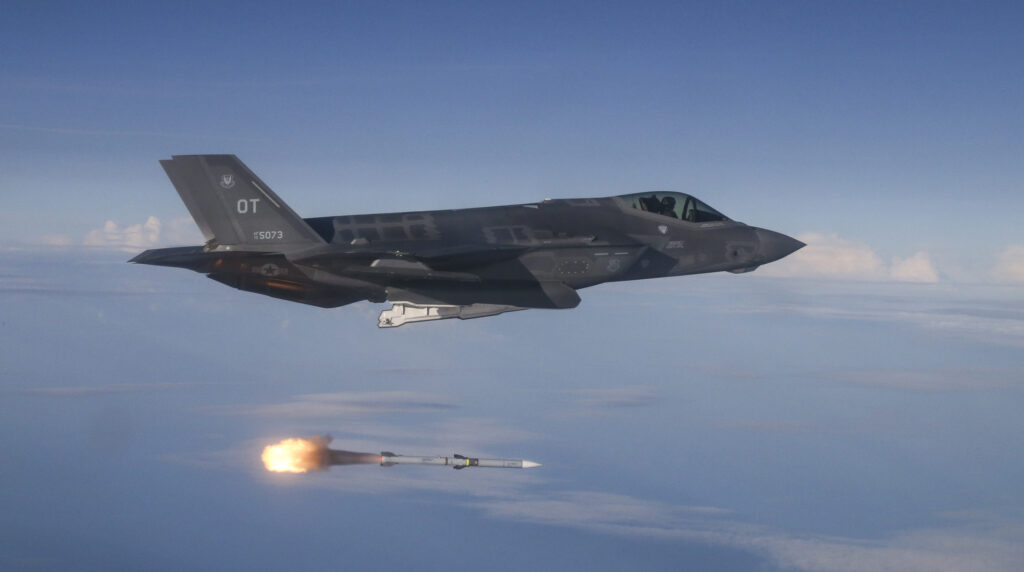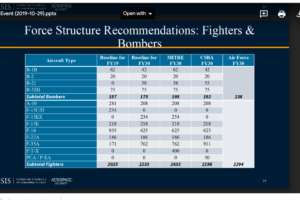
F-35A Lightning II
WASHINGTON: The central question not answered in three new congressionally mandated studies on future Air Force force structure is how to ensure affordability, finds a review by the Center for Strategic and International Studies (CSIS). While the three more or less agree on the overall numbers of fighters and bombers needed in the 2030 force, and that both the B-21 bomber and the F-35A programs should be continued or even accelerated, none of them directly assess how much it will all cost, CSIS says.
In fact, the Air Force’s study is quite clear that it did not factor cost into its analysis, nor did it assume any new technologies coming on line in the 2030 force, explains Todd Harrison, director of CSIS’s Aerospace Security Project. “If you constrain yourself so that you can’t have new capabilities, and you’re fiscally unconstrained, you wind up with a trivial solution: which is just buy more of all the things we’re already buying.”
Harrison explained that the biggest problem for the Air Force right now is growing costs despite a dwindling fleet and sub-optimal mission readiness rates. The current Air Force situation is “like a power-on stall in an airplane,” he said. Despite the budget being “full throttle” and “at an all time high,” the service has fewer aircraft and personnel, a declining mission capable rate, it flies fewer hours per year, and is suffering a higher mishap rate.
According to the CSIS review, the key cost driver is the rising price of operating aircraft — not, as one might assume, due to the increasing age of the fleet or even due to a higher operational tempo (which is actually lower than it was a few years back). Instead, Harrison said, the high costs are caused primarily by maintaining “so many small fleets” of different sorts of aircraft for highly specific missions, such as the B-2 bomber and the RC-135 reconnaissance aircraft. “When you have a large fleet, the cost per plane goes down; for small fleets, the cost per plane goes way up,” he explained. “That’s because you have huge fixed costs with each of your aircraft. … Operating costs of planes is going to be determined by how many you keep in the inventory.”
This is borne out by the three studies, according to CSIS’s review, all of which find that the Air Force should move from “single-mission, platform-centric systems” towards “multi-mission, payload-centric systems.” An example, according to CSIS, is that all three “implicitly or explicitly” endorse moving away from the E-8 JSTARS battle management aircraft to a multi-domain solution that can “leverage other existing platforms where possible.”
Another area where consolidation should be considered is in tankers, Harrison noted. This is also an area where the Air Force might want to consider the potential use of remotely piloted aircraft (RPA), he said. Currently, drones have the highest mission capable rates, are doing the most flying, and cost the least. So looking at them for other missions besides intelligence, surveillance and reconnaissance (ISR) — the bulk of what they do now — and dropping bombs makes sense, Harrison concluded.
The three studies were mandated by Section 1064 of the 2018 National Defense Authorization Act (NDAA), and were undertaken by the Air Force, Mitre Corporation and the Center for Strategic and Budgetary Assessments (CBSA). Harrison said Congress wanted to see a public assessment of how the Air Force’s current wishlist — embodied in the September 2018 “Air Force We Need” study calling for 386 operational squadrons up from the current 312 — might or might not be justified. The NDAA language was modeled on a similar study Congress mandated for the Navy in the 2016 NDAA, he noted.
Of the three, Harrison said, the 158-page CSBA study “comes the closest” to answering the congressional call. The other two, however, “are incomplete” because they fail to show their work in an unclassified form, he said. “Congress wanted it out in the open,” he explained.
On the other hand, he said, it is important to recognize that despite different assumptions going in, the three studies are remarkably consistent on a number of key issues. These areas of consensus, he said, preview where future Air Force decisions on force structure mix and budget requirements are likely to go.
The CSIS review found that the studies agreed on the fact that the pivot to great power competition with Russia and China means that the Air Force needs more long-range, long-loiter platforms: bombers, remotely piloted aircraft (RPA), tankers and even bases to support long-range action. The studies also agree that the increased threat environment means the future force must be more survivable.
The studies say the 2030 force should include between some 2000 fighter jets: MITRE says 2633, CSBA says 2198, and the Air Force called for 2294. This includes 762 F-35A jets recommended by MITRE and 911 recommended by CSBA. The Air Force did not give specific numbers of aircraft in its study, Harrison explained, rather he extrapolated the totals by type of plane from its count of squadrons.
As for the number of bombers needed by 2030, MITRE recommended 195 total, with 38 B-21s; CSBA recommended 192, with 55 B-21s; and the Air Force study recommended a total of 238.
Navy jet trainer fleet operations remain paused after engine mishap
One week after the incident, a Navy spokesperson says the service is continuing to assess the fleet’s ability to safely resume flight.


























